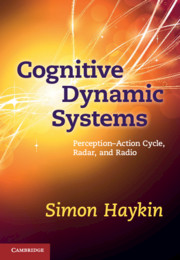Book contents
- Frontmatter
- Contents
- Preface
- Acknowledgments
- 1 Introduction
- 2 The perception–action cycle
- 3 Power-spectrum estimation for sensing the environment
- 4 Bayesian filtering for state estimation of the environment
- 5 Dynamic programming for action in the environment
- 6 Cognitive radar
- 7 Cognitive radio
- 8 Epilogue
- Glossary
- References
- Index
4 - Bayesian filtering for state estimation of the environment
Published online by Cambridge University Press: 05 June 2012
- Frontmatter
- Contents
- Preface
- Acknowledgments
- 1 Introduction
- 2 The perception–action cycle
- 3 Power-spectrum estimation for sensing the environment
- 4 Bayesian filtering for state estimation of the environment
- 5 Dynamic programming for action in the environment
- 6 Cognitive radar
- 7 Cognitive radio
- 8 Epilogue
- Glossary
- References
- Index
Summary
Perception of the environment, viewed as a problem in spectrum estimation as discussed in Chapter 3, is most appropriate for applications where spectrum sensing of the environment is crucial to the application at hand; cognitive radio is one such important application. A distinctive aspect of spectrum estimation is the fact that it works directly on environmental measurements (i.e. observables). However, in many other environments encountered in the study of cognitive dynamic systems, perception of the environment boils down to state estimation, which is the focus of attention in this chapter.
We defer a formal definition of the state to Section 4.4, where the issue of state estimation is taken up. For now, it suffices to say that estimating the state of a physical environment is compounded by two practical issues:
(1) The state of the environment is hidden from the observer, with information about the state being available only indirectly through dependence of the observables (measurements) on the state.
(2) Evolution of the state across time and measurements on the environment are both corrupted by the unavoidable presence of physical uncertainties in the environment.
To tackle perception problems of the kind just described, the first step is to formulate a probabilistic model that accounts for the underlying physics of the environment. Logically, the model consists of a pair of equations:
a system equation, which accounts for evolution of the environmental state across time, and
a measurement equation, which describes dependence of the measurements on the state.
- Type
- Chapter
- Information
- Cognitive Dynamic SystemsPerception-action Cycle, Radar and Radio, pp. 77 - 124Publisher: Cambridge University PressPrint publication year: 2012



